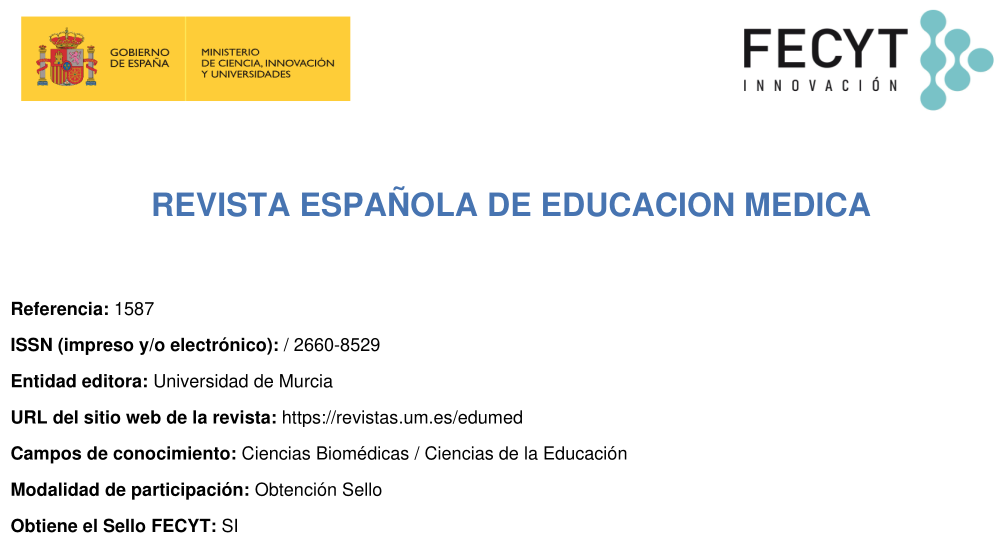Perception of clinical simulation as a didactic in the teaching of postpartum hemorrhage in undergraduate medicine
Abstract
Objective: To determine the perception that undergraduate medical students have of high-fidelity clinical simulation workshops used in obstetrics in simulated emergency scenarios in postpartum hemorrhage. Materials and methods: Cross-sectional, quantitative study, with a descriptive approach, with a sample of 49 individuals, a questionnaire was made with Likert-type scales that evaluated the perception of medical students about simulation as a didactic strategy for teaching postpartum hemorrhage, through of a satisfaction survey, and with statistical analysis using SPSS software. Results: The perception of the simulation workshop was defined as positive in 89.4% of the students, the utility was considered favorable in the majority (74.5%), 57.4% of the students considered that the simulation achieves improvement in clinical skills, 89.4% consider that it strengthens confidence and 76.6% state that simulation should be a mandatory component in the medical training process. Conclusions: The clinical simulation is a didactic tool that has been shown to be perceived as favorable by the majority of students who attend emergency scenarios of postpartum hemorrhage care, the workshops are accessible for the teaching-learning process from the safety of the patient and the training process in times of pandemic where access to health areas is restricted, being received positively by students in the areas of improvement in clinical skills, in confidence and therefore they consider that it should be a didactic tool in the undergraduate medicine curriculum.
Downloads
Metrics
-
Abstract1312
-
pdf (Español (España))942
References
Amaya A. Simulación clínica y aprendizaje emocional. Rev Colomb Psiquiatr [Internet]. 2012;41:44–51. Available from: http://www.scielo.org.co/pdf/rcp/v41s1/v41s1a06.pdf
Mortalidad materna [Internet]. [cited 2020 May 27]. Available from: https://www.who.int/es/news-room/fact-sheets/detail/maternal-mortality
Díaz-Guío DA, Cimadevilla-Calvo B. Debriefing y sus fundamentos [Internet]. Vol. 1, Revista Latinoamericana de Simulación Clínica. 2019. p. 95–103. Available from: https://www.medigraphic.com/cgi-bin/new/resumen.cgi?IDARTICULO=88669
Shanks D, Wong RY, Roberts JM, Nair P, Ma IW. Use of simulator-based medical procedural curriculum: The learner’s perspectives. BMC Med Educ. 2010;10(1). https://doi.org/10.1186/1472-6920-10-77
Scholz C, Mann C, Kopp V, Kost B, Kainer F, Fischer MR. High-fidelity simulation increases obstetric self-assurance and skills in undergraduate medical students. J Perinat Med. 2012;40(6):607–13. https://doi.org/10.1515/jpm-2012-0052
Gaba DM. The future vision of simulation in health care. Qual Saf Heal Care. 2004;13(SUPPL. 1):2–11. https://doi.org/10.1136/qhc.13.suppl_1.i2
Breuer G, Schweizer K, Schüttler J, Weiß M, Vladut A. “Sprung ins kalte wasser”. Simulatorbasiertes lernen in akutmedizinischen bereichen. Anaesthesist. 2014;63(1):16–22. https://www.springermedizin.de/sprung-ins-kalte-wasser/8005470
Patricia D, Mahecha G, Pinzon MP. Percepción de los estudiantes de enfermería de la pontificia universidad javeriana sobre el aprendizaje a traves de simulación clínica. 2013;(X). https://repository.javeriana.edu.co/handle/10554/13761
López Sánchez M, Ramos López L, Pato López O, López Álvarez S. La simulación clínica como herramienta de aprendizaje. Cir May Amb 2013 [Internet]. 2013;18(1):25–9. https://pesquisa.bvsalud.org/portal/resource/pt/ibc-111965?lang=es
Barsuk JH, McGaghie WC, Cohen ER, Balachandran JS, Wayne DB. Use of simulation-based mastery learning to improve the quality of central venous catheter placement in a medical intensive care unit. J Hosp Med. 2009;4(7):397–403. https://doi.org/10.1002/jhm.468
Kuduvalli PM, Jervis A, Tighe SQM, Robin NM. Unanticipated difficult airway management in anaesthetised patients: A prospective study of the effect of mannequin training on management strategies and skill retention. Anaesthesia. 2008;63(4):364–9. https://doi.org/10.1111/j.1365-2044.2007.05353.x
Moya P, Ruz M, Parraguez E, Carreño V, Rodríguez M, et al. Efectividad de la simulación en la educación médica desde la perspectiva de seguridad de pacientes Simulation in medical education from the perspective of patients’ safety. Educ MÉDICA Rev Med Chile. 2017;145:514–26. http://dx.doi.org/10.4067/S0034-98872017000400012
Rodríguez J, Laura, Agea D, Luis J, Lapuente P, Luisa M, et al. The clinical simulation as a teaching tool. Perception of students degree in Nursing UCAM (San Antonio Catholic University of Murcia-Spain) | La simulación clínica como herramienta pedagógica. Percepción de los alumnos de Grado en Enfermería en la UCAM (U. Enferm Glob. 2014;13(1):175–90. http://dx.doi.org/10.6018/eglobal.13.1.157791
Díaz-Guio DA, Ricardo-Zapata A, Ospina-Velez J, Gómez-Candamil G, Mora-Martinez S, Rodriguez-Morales AJ. Cognitive load and performance of health care professionals in donning and doffing PPE before and after a simulation-based educational intervention and its implications during the covid-19 pandemic for biosafety. Infez Med. 2020;28:111–7. https://pubmed.ncbi.nlm.nih.gov/32532947/
Copyright (c) 2022 Servicio de Publicaciones de la Universidad de Murcia

This work is licensed under a Creative Commons Attribution-NonCommercial-NoDerivatives 4.0 International License.
The works published in this magazine are subject to the following terms:
1. The Publications Service of the University of Murcia (the publisher) preserves the economic rights (copyright) of the published works and favors and allows them to be reused under the use license indicated in point 2.
2. The works are published under a Creative Commons Attribution-NonCommercial-NoDerivative 4.0 license.
3. Self-archiving conditions. Authors are allowed and encouraged to disseminate electronically the pre-print versions (version before being evaluated and sent to the journal) and / or post-print (version evaluated and accepted for publication) of their works before publication , since it favors its circulation and earlier diffusion and with it a possible increase in its citation and reach among the academic community.


















